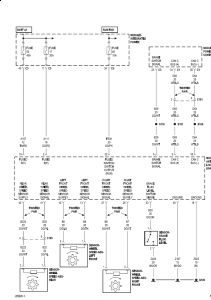The ABS system has nothing to do with a two or four-wheel drive system. If you have the four-wheel ABS system, all four wheels are controlled individually. All cars with anti-lock brakes have this type of system. If you follow the two steel brake lines coming out of the brake master cylinder, they'll go into a fairly large hydraulic controller with four lines coming out, one for each wheel. You'll usually also hear the buzzing and banging when the system is preventing a skid. With this system, when you press the brake pedal, the computer looks at all four wheel speeds, disregards the fastest one, then of the other three, it reduces brake pressure to the one wheel that's turning a certain percentage slower than the other two.
The rear-wheel anti-lock system, called "RWAL" for short, is only used on trucks. Doesn't matter if it's a two or four-wheel drive truck. This system only reduces brake pressure to the two rear wheels together when either one of them slows down too quickly. Their speed is not compared to the front wheels. Whether or not to reduce brake pressure is determined strictly by the RATE of slow-down. Skidding tires have no traction. The goal of the RWAL system is to prevent the rear of the truck from passing the front in slippery conditions. The front wheels can still lock up and skid with this system.
Also, with the RWAL system, very often that computer can only store one diagnostic fault code at a time. On many Chrysler products that code can only be erased with a scanner that can access the ABS Computer. Disconnecting the battery won't do it. Many aftermarket scanners won't either so you might need the Chrysler dealer's scanner. I have one and a lot of independent shops do too because with a plug-in card, it will work on all brands of vehicles sold in the U.S., at least for emissions-related stuff.
If a second problem develops with the RWAL system and it can't store a second code, that second one will show up as soon as the first problem is fixed and that code is erased. If you have the original problem fixed right away, there's rarely a second code waiting to show up. If you wait months or years like some people, it is very likely a second problem occurred. No one will know, including your mechanic, until that first problem is fixed. Then, when the warning light turns on again and there's a new code in memory, you're not happy when you're told more work is needed beyond the original estimate, and your mechanic is not happy having to tell you that more repairs are needed.
If you have the four-wheel ABS, one of the more common problems is a defective front wheel speed sensor. With the RWAL system, there are two things I remember running into on Dakotas. There is only one wheel speed sensor inserted into the top of the rear differential housing. If enough metal chips collect on the magnet they will reduce the signal to the point the computer won't see it. Removing and cleaning the sensor will take care of that. That sensor also has a two-wire connector attached to the left frame rail. I had one that wasn't sealed properly and got moisture inside and developed corrosion on the connector pins. The fault code will be related to "speed signal missing". Those sensors rarely fail on their own. Failure is almost always due to corrosion, metal chips, or a cut wire.
The other somewhat common problem involves an intermittently shorted solenoid coil in the valve assembly. The short may only occur on bumpy roads. If it does occur at the same time the computer is sending current to it, the excessive current will blow an internal fuse in the computer module. The fault code will be "internal fuse failure". That requires replacement of the computer but very often the new one fails too in a short time because the original cause, that shorted valve assembly, wasn't replaced at the same time.
Regardless which system you have, don't overlook something as silly as low brake fluid level. The yellow ABS warning light will be turned on along with the red brake system warning light. If you do have to add fluid, never fill it to the top. Just add enough new, clean fluid from a sealed container to reach the "minimum" level. Also be extremely careful to not get any contaminants in that fluid. Mainly that means any hint of petroleum product such as engine oil, transmission fluid, and power steering fluid. If you have grease on your fingers, don't use them to push the rubber bladder seal back into the reservoir cap either. Any such contamination will lead to a very expensive repair.
This guide will help you figure out whats wrong
https://www.2carpros.com/articles/abs-warning-light-on-easy-repair-guide
Monday, February 13th, 2012 AT 2:27 AM


